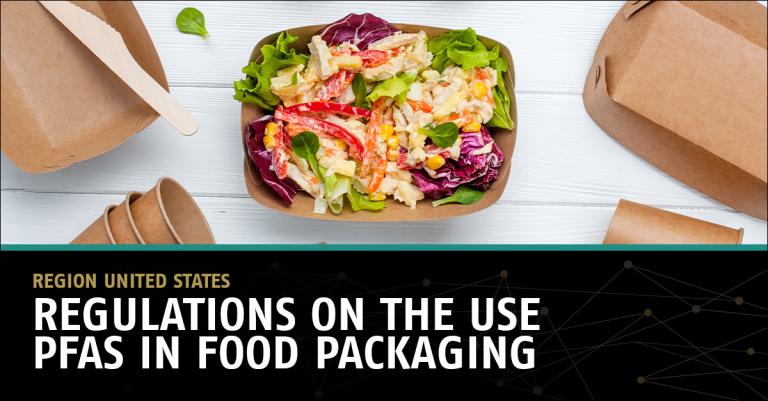Regulations on the use PFAS in food packaging in the United States
Per- and polyfluoroalkyl substances (PFAS) are a large family of chemicals used in a variety of everyday products. Due to their high persistence in the environment and concerns over potential adverse health effects, there has been a rise in regulations on the use PFAS in food packaging in the United States (US):
- More than 20 US states have enacted laws targeting PFAS. These regulations set drinking water concentration limits and ban PFAS in many consumer products including packaging, textiles, and cosmetics. There is variability in the types of packaging covered, the compliance deadlines, and the enforcement mechanisms. Examples of recent and upcoming PFAS food packaging regulations include:
- Starting January 1, 2023, California will prohibit the distribution and sale of plant fiber-based food packaging containing regulated PFAS. This prohibition includes PFAS that are intentionally added as well as unintentionally added PFAS that are breakdown products at or above 100 parts per million (ppm).
- Connecticut’s PFAS ban comes into effect December 31, 2023, and will ban intentionally added PFAS in any food packaging or food packaging component, including paper, metal, glass, and plastic. This regulation includes a provision that any substance used to replace PFAS must not create a safety hazard equal or greater to that of PFAS.
- The US Environmental Protection Agency (EPA) has proposed a drinking water limitation for six PFAS on March 14th, 2023. This proposed limit went through a public comment period, which ended on May 4th.
- The EPA also proposed a Significant New Use Rule (SNUR) in December 2022 which would require reporting of PFAS production dating back to January 1, 2011. This rule is expected to be published in late Q3 or Q4 of 2023.
- The US EPA also proposed an update rule on May 26th to the new chemicals regulations. One of these changes is to 40 CFR 723.50 which renders PFAS categorically ineligible for Low Volume Exemptions (LVE). This rule will likely be finalized sometime next year and would move PFAS from ineligible for an LVE by policy to ineligible by law.
In addition to the US, the EU’s Chemical Strategy for Sustainability includes a comprehensive set of actions around PFAS with a goal to phase them out in the EU for any nonessential use.
o PFAS are currently regulated under EU’s Regulation on Registration, Evaluation, Authorisation and Restriction of Chemicals (REACH). There is a proposal issued February 2023 which is currently under a six-month public consultation period. This proposal would ban the manufacture, use and placing on the market of any regulated PFAS and would be in effect 18 months from the entry into force.
o PFAS are currently also restricted under EU’s Persistent Organic Pollutants (POPs) regulations.
- EU member states are also targeting PFAS in packaging. Denmark banned PFAS from all paper and board food packaging as of 2020 and France recently released an action plan dedicated to PFAS.
knoell can support your organization in understanding the complicated topic of PFAS regulations:
- Strategic and regulatory consulting and training on PFAS
- Watchdog Service: Keep your organization up to date with new regulatory developments including the complex web of PFAS regulations globally including the US and EU
- Strategic Substance / Portfolio analysis: Evaluation of substance portfolio regarding potential PFAS concerns
- Sustainable Chemicals by Design: Evaluating the hazard and risk assessment of PFAS replacement chemicals (Regulatory support, QSAR) Life Cycle Assessment (LCA) to assess impact of switching to a PFAS alternative on your packaging.


